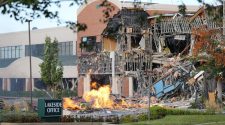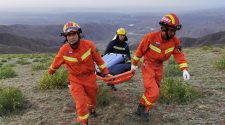But on Thursday, health authorities in Hubei, the province at the center of the epidemic, announced there had been nearly 15,000 new cases overnight — almost 10 times the number of cases announced the previous day.
The government was quick to point out the outbreak didn’t suddenly get much worse; the authorities had simply changed the way they reported cases in order to allow more people to access treatment faster.
The shift in how new cases are diagnosed has compounded questions about whether the world can rely on the numbers coming out of China, amid criticism over the government’s handling of the outbreak.
How has China changed its method?
The total number of cases reported by China now includes “clinically diagnosed cases.” These are patients who demonstrate all the symptoms of Covid-19 but have either not been able to get a test or are believed to have falsely tested negative.
Fisman said this was a positive move by the Chinese health authorities. “They should be applauded for that because they’re casting the net wider to try to do a better job of controlling spread from people who may not have a firm diagnosis yet,” he said.
If the sudden huge spike in the numbers is unnerving to some, it doesn’t actually mean an increase in the number of people who’ve fallen ill. In fact, Fisman said it would be “phenomenally irresponsible” to say the epidemic got worse. “The case definitions change, that’s a good public health practice, they don’t want to miss cases,” he said.
Delays in testing are not confined to China. In the US, the Centers for Disease Control (CDC) currently requires that all potential samples are shipped to its central laboratories for full testing.
Speaking at a US Senate hearing on Wednesday — before China’s announcement — Scott Gottlieb, former commissioner of the US Food and Drug Administration, urged a similar change in procedure in the US to rein in any potential outbreak. He said that testing was not been done aggressively enough and should be expanded to cover more symptoms.
“I think that we should be leaning in very aggressively to broaden diagnostic screening right now, particularly in communities where there was a lot of immigration, where these outbreaks could emerge, to identify them early enough that they’ll be small enough that we can intervene to prevent more epidemic spread in this country,” he said.
Should we be more skeptical about what China is saying?
The World Health Organization has backed China and the way it now reports the numbers. But many have expressed alarm about taking the figures at face value, given the government’s track record of suppressing information about this and previous crises.
“I don’t trust the reporting in China, and I also believe that the China numbers reflect the most severe cases, so we’re getting a skewed view of the case fatality rate and how severe this is,” he said Wednesday.
Fisman said that while the real numbers are likely to be somewhat higher than the official ones, most of the discrepancy probably involves mild cases.
“What I can tell you as someone who models infectious diseases, the virologically confirmed case numbers make sense to me,” he said.
However, there are some questions remaining.
“In China, the party line is ‘this started in December’,” Fisman said. “Those of us who are lucky enough not to have to parrot an official truth are able to say no, no, the phylogenetic data from the virus says early November, and epidemic models based on exported case counts, which we do trust, say early to mid-November.”
China’s leaders have promised absolute transparency on the virus — and the WHO has praised them for sharing information. Beijing has also vowed severe punishment for any officials found to be concealing or downplaying figures related to the outbreak.
Will we ever know the true number?
It can take years to get the real picture of an epidemic. Establishing the true extent of the SARS outbreak in 2002 and 2003 was a long-term process, partly because China suppressed the reporting of it in the initial months.
But even if the authorities do everything they can to disclose accurate numbers, the full picture won’t be complete until much later.
Testing could be an issue too. Asha George, executive director of the Bipartisan Commission on Biodefense, told the same US Senate hearing on Wednesday that China may be limited in its testing and reporting resources, versus simply “a lack of desire on the part of the Chinese government to report.”
“We won’t really know what the true case fatality for this is until probably months or years from now when people do … blood tests and find out how many silent infections that were in the population,” Fisman said.
He added that at the moment, health experts don’t have a clear idea on how many of the cases reported from China is happening in health care centers and hospitals, where the fatality rate could be higher, because people who are in a hospital for another reason are more vulnerable.
What does it mean for the world if we don’t know the true number?
Of course, having accurate information is key to combating an epidemic, because it helps epidemiologists forecast the spread of the disease, which in turn allows public health officials to put necessary measures in place.
But while the number of reported cases plays a role, it is not the only — and in some cases not even the most important — way to measure an outbreak.
“We always measure big epidemics indirectly, usually using a few different data sources, knowing that all of them are going to be wrong in different places, but that the combined picture often is very, very helpful in terms of figuring out what must be going on,” Fisman said.
Most epidemiologists know what the pitfalls are and can work around them, he said.
George told lawmakers that students at public health schools are often taught to “multiply by seven or eight times what you’ve been told” to account for cases that they can’t see.
“For every one case you see, there are seven or eight out there that you don’t,” she said.



















